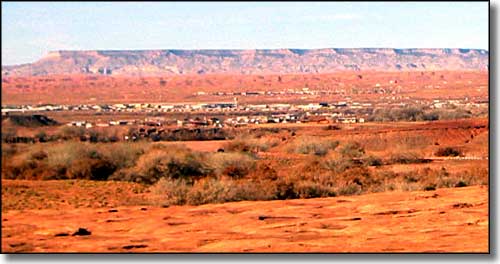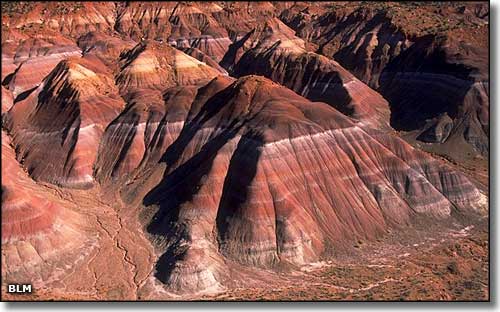
Chinle, Arizona

The Chinle Valley
Chinle is the gateway to Canyon de Chelly National Monument in the Navajo Nation. Canyon de Chelly is unique in the National Park system in that the area wasn't just inhabited 2,000 years ago, it still is inhabited with members of the tribe living all through the floor of the canyon. Because of that, the floor of the canyon is mostly off-limits to visitors. Being in the Navajo Nation, there is a branch of Diné College and a branch of Northern Arizona University in Chinle.
From about 1790 on, Spanish/Mexican trade extended this far north, until the era of the American occupation. The Navajos had a thing for stealing sheep and other possessions from their neighbors and that eventually led to the US Army sending troops here under the command of Col. Kit Carson. As much as Carson didn't want anything to do with the project, he followed orders and eventually rounded up 8,000-to-12,000 members of the Navajo Nation and force marched them to Bosque Redondo in eastern New Mexico (near Fort Sumner). That "experiment" ended in abject failure, but not before hundreds, if not thousands, of Navajos died. Four years later the federal government allowed the tribe to return to their former homelands.
The first trading post was established at Chinle in 1882 in a tent. Denis Riordan, the actual Navajo Agent, came in the next year and evicted that trader. Then Samuel Day and Anson Damon built an actual trading post in 1885, but ownership of the post seems to have changed hands about every year. The first Franciscan missionaries arrived around 1904 and the government opened a school at Chinle in 1910.
The name "Chinle" also refers to a geological formation of banded depositional sandstone laid down in the Late Triassic Age across northern Arizona, Utah, Nevada and western New Mexico and Colorado. The Chinle Formation may be up to 1,800' thick and often holds dinosaur fossils.

The Chinle Formation
Latitude: 36.1547°N
Longitude: 109.579°W
Census Designated Place
Elevation: 5,506'
Education:
High School or Higher: 63.8%
Bachelor's Degree or Higher: 17.1%
Graduate or Professional Degree: 9.0%
2011 Cost of Living Index for Chinle: 79.4
Estimated Median Household Income: $19,950
Estimated Median Home Value: $60,500
Median Resident Age: 21.9 Years
Major Industries:
Educational Services, Health Care, Construction, Government, Lodging & Food Services, Social Services, Utilities, Retail Services, Rail Transportation
Unemployed (March 2011): 16.5%
2010 Population Demographics
| Total Population | 4,518 |
| Males | 2,109 |
| Females | 2,409 |
| Population by Age | |
| Under 18 | 1,753 |
| 18 & over | 2,765 |
| 20-24 | 281 |
| 25-34 | 572 |
| 35-49 | 803 |
| 50-64 | 601 |
| 65 & over | 307 |
| Population by Ethnicity | |
| Hispanic or Latino | 116 |
| Non Hispanic or Latino | 4,402 |
| Population by Race | |
| White | 284 |
| African-American | 12 |
| Asian | 12 |
| Native American | 4,129 |
| Hawaiian or Pacific Islander | 0 |
| Other | 3 |
| Two or more | 78 |
